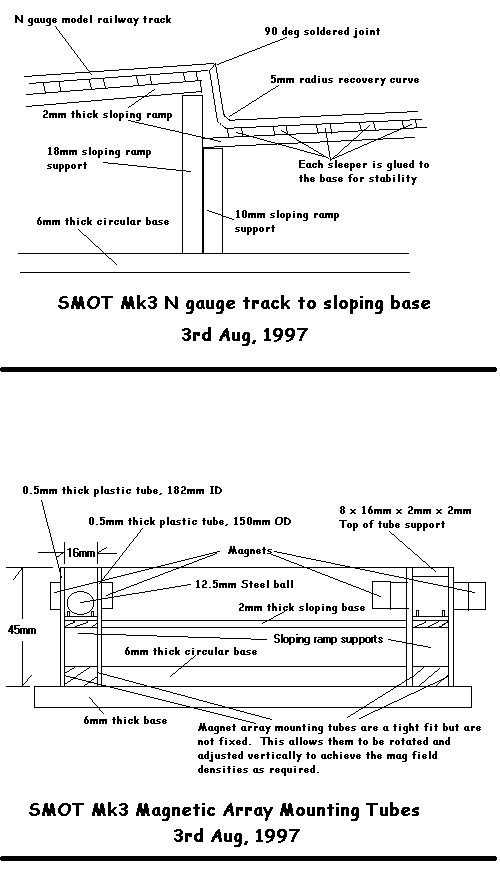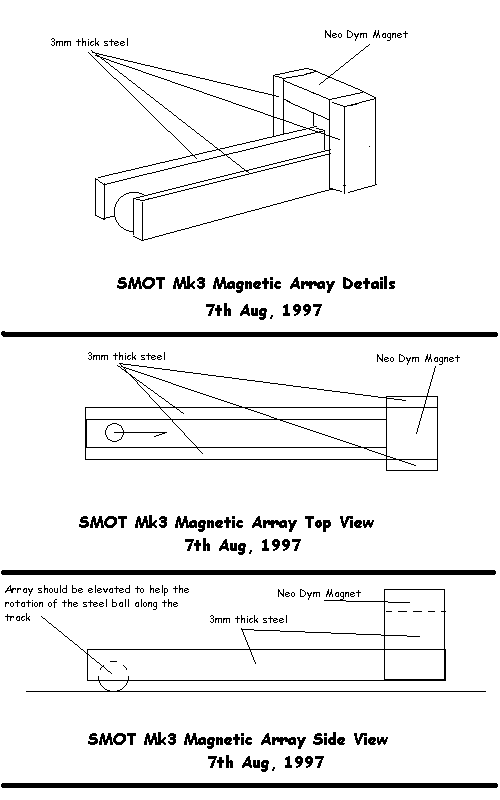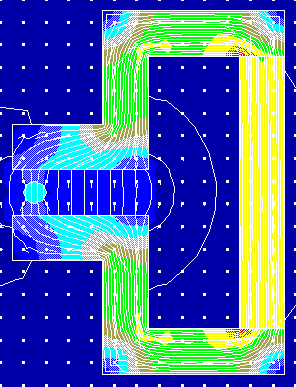
SMOT - Mark III
by Greg Watson
created on 08/07/97 - JLN Labs - Last update 08/05/97
Texts, schemes, and test report by Greg Watson
In all SMOT ramps developed to date, the magnet arrays were built first and then the ramp was adjusted to best suit the arrays magnetic fields. While this approach has worked for many, I believe it is wrong and has been the major source of many SMOT failures for others.
In the development of the SMOT Mk3 single circular ramp, the ramp was designed first and THEN the necessary magnetic field profiles were adjusted to the ramp and the job it was required to do. This approach, which is probably the correct way to go, has resulted in a relative simple to build and adjust circular ramp.
The SMOT Mk2 single circular ramp is formed of flexible N gauge model railway track. The track is secured to a strong and stable circular ramp with a 8mm overall lift and an average length of 521.5mm. The ramp has an inside diameter of 150mm and an outside diameter of 182mm and an average diameter of 166mm. The ramp is 16mm wide, which is the width of the 16mm wide sleepers of the N gauge track. The ramp has a lift of 1.53mm per 100mm of track. This is a very gentle ramp slope in comparison to the SMOT Mk1 & Smot Mk2 ramps. The steel ball is 12.5mm in diameter and is Chrome plated.
Unlike the SMOT Mk1 & SMOT Mk2 ramps where the ramp and the magnet arrays were parallel, the SMOT Mk3 magnet arrays are not. The SMOT Mk3 circular magnetic arrays have a 14mm differential between the bottom and top of the ramp. At the bottom, the centre line of the magnetic arrays are 2mm below the centre line of the steel ball and at the top, the centre line of the magnetic arrays are 4mm above the centre line of the steel ball. The magnetic arrays are not linear and for most of the array length, their centre line is 3mm above the steel ball's centre line. This above position assists the steel ball's rotation as it produces more attractive force on the top of the ball than the bottom. It also greatly reduces noise generating as there is less slip between the ball and the track.
The best results to date (2nd Aug, 1997) have been about 5 minutes of operation before the ball gets stuck at the exit point (either doesn't drop or gets sucked side ways). The average "Rollaround" time is just over 1 minute to date.
The ball will climb the ramp from most starting points (95%) on the circular ramps 521.5mm average length, but I start the "Ball Rolling" by gently pushing the ball off the top of the ramp.
I have built 2 SMOT Mk3 ramps to date. I am continuing the development of the 2nd unit to increase the stability of its operational characteristics and improve it "Rollaround" performance. I have found that exit guides (reducing the exit width to 13mm) help to reduce "Side Sticks", but I am still testing methods to eliminate exit hangs by experimenting with different exit radius curves. The exit is velocity sensitive as most SMOT builders know only too well. The original SMOT Mk3 units had sharp 90 deg top exits and 5mm bottom recovery curves like the SMOT Mk2 ramps.
Just to repeat by earlier statement on my SMOT Mk2 kits.
ALL SMOT Mk2 kit purchasers will receive a SMOT Mk3 single circular ramp at No Extra Charge. When the SMOT Mk3 single circular ramp is stable and easy to manufacture, I will start shipping SMOT Mk3 kits in place of SMOT Mk2 kits.
SMOT Mk3 Circular ramp construction details
(Use mouse right click to save to disk)

In construction the sloping N gauge base, strength and stability are very important. Also remember that the inner and outer radius of the lower, upper and sloping ramp supports must be parallel and at right angle to the square base as they provide the support for the 0.5mm thick plastic magnet array support tubes. These tubes MUST fit snug against the inner and outer edges of the construction. More on the tubes later.
N Gauge model railway track mounting details and
Magnetic Array mounting tubes details here.

The magnetic array for the SMOT Mk3 is VERY different to the arrays which have been developed for the SMOT Mk1 & SMOT Mk2 ramps. The older ramps were designed to provide a lot of magnetic differential across the steel ball to climb the much steeper Mk1 & Mk2 ramps. As the Mk3 ramp is very gentle (1.5mm lift in 100mm) not as much magnetic differential is required and as the ramp is very long (521.5mm) , the mag field must provide positive thrust for the steel ball along the entire length of the ramp. This required a new approach to the design of the necessary magnetic fields.
What I came up with is an approach, which to my knowledge is very new and based on the use of a SINGLE Neo Dym magnet and steel flux guides. This design uses the steel's soft domain alignment capabilities and magnet's flux much more efficiently in coupling to the steel ball. I will post a few magnetic simulations which will help to explain WHY this magnetic array design works. Without the steel ball, there is very little flux gradiant in the magnetic gap. The steel ball changes the whole flux flow due to the soft domains in the 3mm thick steel side pieces. Due to the soft domains (and their ability to align in the path of least reluctance), more flux is delivered to the front of the ball than to the back and therefore the ball is drawn up the ramp. As the array is raised above the ball, extra rotational energy is delivered to the ball as well. The design also allows 0mm dropaways on exit.
SMOT Mk3 Magnetic Array Construction Details.
While a straight array is shown, the design can be curved as well.

Quick Field Simulation of SMOT Mk3 Magnetic Array.

![]() Email
: JNaudin509@aol.com
Email
: JNaudin509@aol.com
Return to the SMOT page